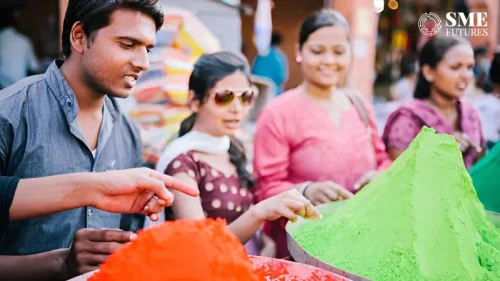We binge on it when bored. It’s fun, crisp and engaging.
These 30 seconds to one-minute-long videos are snackable, straightforward and ideal for reaching consumers, proving to be perfect for entertainment and marketing purposes. Adding to it, their mild addictiveness leading to the ‘just one more and I am done’ attitude, has captured a huge market globally over the years. To be more precise; here are some fun facts for you.
Considering the fact that it’s easy to share and laughter inducing, video content gets 48 per cent more views on social media.
An average TikTok user spends around 26 minutes on the platform per day, and that’s a lot of videos.
YouTube’s Shorts get 3.5 billion views a day.
If you are on Facebook, don’t be surprised when I say that you spend half of your time on it watching videos. In fact, 50 per cent of Facebook’s ad revenue comes from mobile-first video ads.
It all started with Vine
Before 2012, no one could have imagined that a six-second looping video app, Vine (officially launched in 2013) will become the pioneer of a new market segment across the globe.
If you remember Vines or loops have given us so many entertainers like Zach King of Magic Vines, Lele Pons (now a chart-topping singer), Liza Koshy, Andrew Bachelor aka King Bach, Anwar Jibawi, Amanda Cerny and many more such talented performers and influencers, most of whom continue to entertain us to date.
Also Read: Mobile Premier League lays off 100 employees, exits Indonesia
Meanwhile, Snapchat, Dubsmash, Instagram, TikTok, Facebook, YouTube and other similar apps have all made an enormous impact on the way we consume videos today.
If we talk about India, here too the popularity and consumption of short form video content has grown exponentially over the years. In fact, this format has its own separate user and fan base, especially TikTok until last year. You may be aware of the TikTokers VS YouTubers fight in India. But things changed significantly for the Indian market when in June 2020 TikTok was banned along with other Chinese apps.
With TikTok gone, in a short span of time, domestic players launched similar or cloned apps. Now, the short form video market, claimed to be created by TikTok in India is flourishing and growing by leaps and bounds. Estimates state that around 40 per cent of the market is now dominated by Indian apps.
Let’s talk about a few recent statistics that prove that short-form video content is on the rise and that Indian made apps are doing great in the market.
Indians love entertainment
Do we even need to look at statistics to realize that we Indians love entertainment?
However, just for the record, Indians are the biggest content consumers in the world as per RedSeer Research.
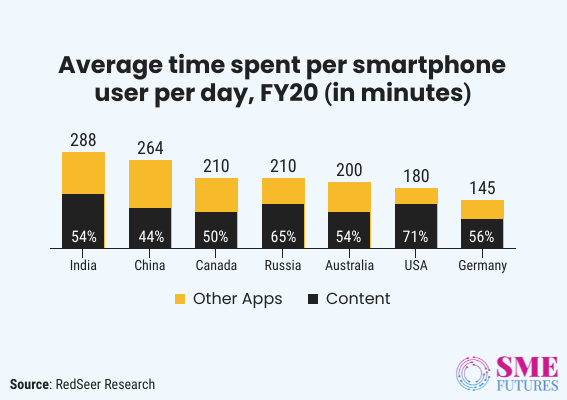
And the reason behind our highest rank in this space is that India has a high content creation velocity, which means that we are continuously creating content in various formats, especially on OTT and short form video platforms. Secondly, in the last three to four years the tech milieu in India has engendered the prolific creation and launch of a myriad new content apps. Finally, the availability of cheap internet services has made it convenient for almost anyone to access all kinds of entertainment via smartphones and other devices.
Not only that, but India also has the highest content consumption per user as well. Which means that every second, a person in India accesses the internet. It was also noted that a user spends 1/5 th of their day on smartphones in India.
Indians are prolific makers of Reels, stories and shorts
Due to the immense popularity of short form videos, their consumption has also increased dramatically. In less than five years, the active users base has increased by 9x on a monthly basis. Analytics point out that around 45 per cent of internet users consume short form video content.
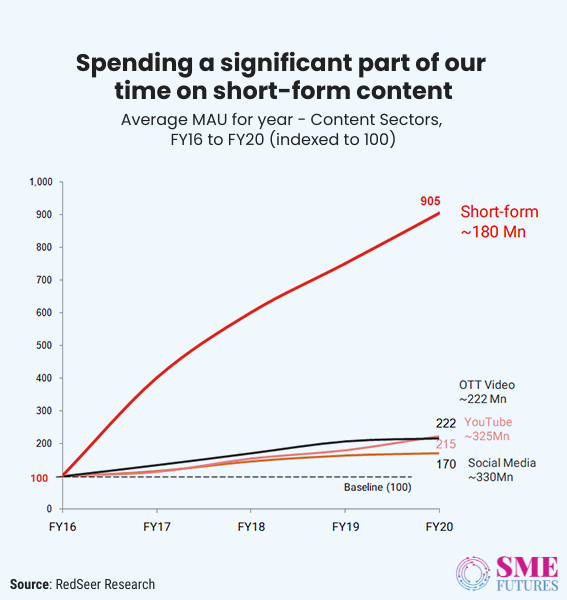
Upon observing the growing engagement on the short form video platforms, market giants such as Instagram, Facebook, YouTube, also hopped on to the short form bandwagon with Reels, FB Stories and YT Shorts in 2020.
However, Indian short form video making apps are gaining immense popularity among consumers.
Out of the total users consuming short form videos, at least 40 per cent spend most of their online time on Indian apps. Here is how users spent time on the various apps last year.
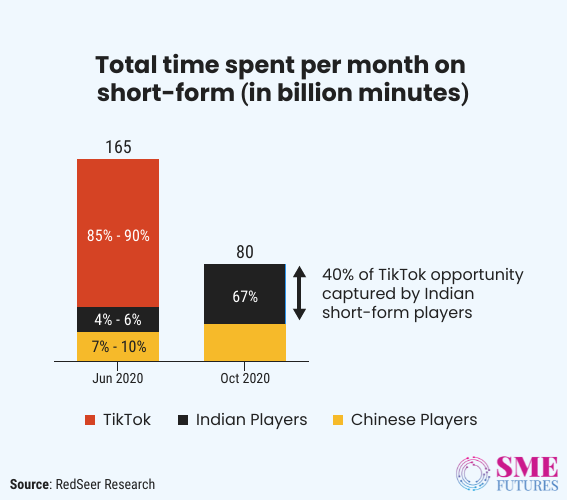
Mirror apps have captured the Indian market
Perusing the data about the time spent on these Indian apps, it becomes apparent that the vacuum created after the TikTok ban has already been filled by them. 40 per cent of the market is now dominated by Indian apps.
Also Read: Govt approves guidelines for small business cluster development programme for 2021-26 period
In fact, in less than a year, Indian short video apps have witnessed a V-shaped growth curve.
With this, the user base is nearly back to 100 per cent of the TikTok user base levels, driven by aggressive marketing and user acquisition by various platforms.

The time spent on these apps has so far reached 55 per cent of the levels recorded in June 2020 which was before the TikTok ban. This evidently shows that the domestics players have more scope to grow.
Similar features, creativity and accessible formats have propelled ex TikTok users to move to Indian short form apps, resulting in the retention of over 65-70 per cent of TikTok users. Through aggressive marketing, these apps also onboarded around 30-35 per cent new users over the past year.
According to expert opinion, this trend is mostly driven by the stronger focus by these platforms on vernacular content and their ‘Bharat’ positioning. Overall, 60-62 per cent of short form users are from Tier 2+ cities.
At the same time, 75 per cent of current short form video users will likely stick to these domestic apps and are unlikely to switch back to Chinese apps even if the ban is lifted. This is evidence of the user’s satisfaction and loyalty towards these apps.
Here is what users have to say about Indian apps.
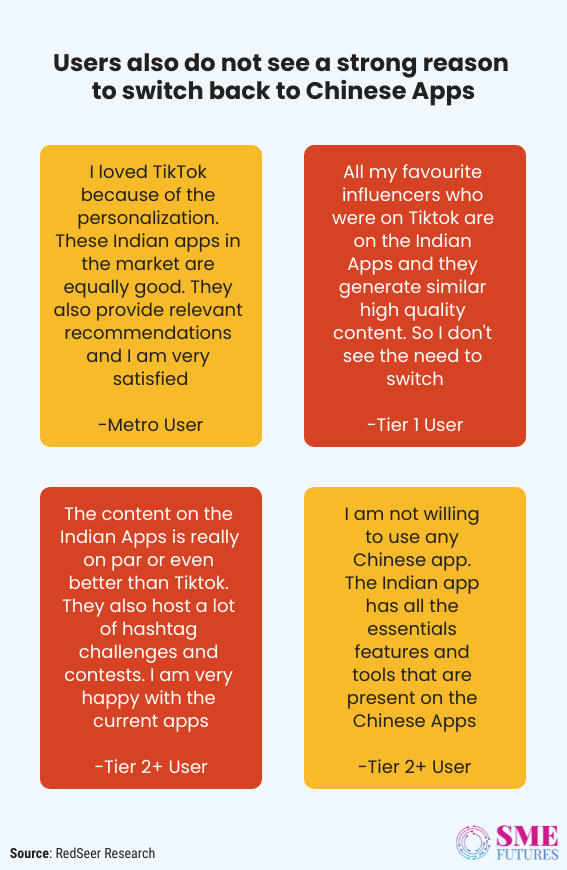
Apps are minting Influencers
Users on these apps can be categorised into creators and their followers. Usually both depend on each other, thus propelling the further growth of these platforms. Many of them gradually become influencers—creators who have a huge follower base. Influencers can influence purchase decisions by marketing brands and products through their content and they too can earn money through these paid partnerships.

Clearly, these apps are aggregating users’ day by day with creative content and trending videos. This fuels ecosystem growth, leading to a large monetisation potential for both influencers and platforms.
The RedSeer analysis says that elite influencers with more than 10 million followers can earn around $20,000-40,000 monthly. Influencers with one million followers can earn up to $1000-2500 while budding creators with less than 1 million followers can earn $40-200.
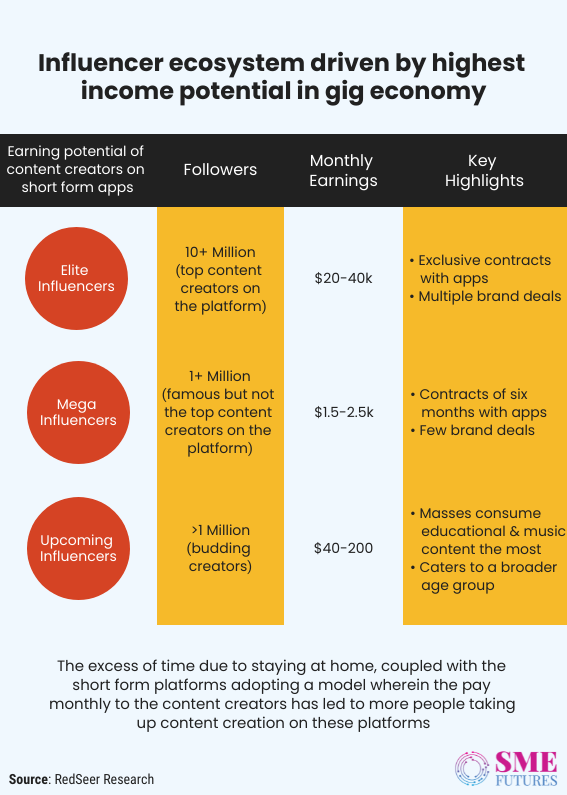
This is also one of the many reasons for the tremendous popularity of these apps.
Leaders of the market
As per research, four Indian video content apps—Josh, Moj, MX Takatak and Roposo have captured most of the attention in a short span of time. Sharechat launched its short video app Moj to quickly fill the gap created by TikTok and acquired a mass user base. Similarly, Dailyhunt and MX Player too launched Josh and TakaTak respectively within the first week of the ban.
Roposo, a leading short-video platform in India, launched in 2014, witnessed a sudden spike in its user base and the app downloads reached over 75 million. Moj has recorded a maximum surge in app downloads with over 50 million downloads as of the first week of August.
As per Praxis Global Alliance Labs, immediately after the TikTok app ban, 7 of the top 10 apps were TikTok clones.
And the competition among them is cutthroat.
Here is a comparison between Josh, Moj and MX TakaTak which shows how they have been continuously making great efforts to attract new users by creating social media challenges and collaborating with TV shows, sports leagues, etc. And these start-ups are also endorsing and sponsoring events for better visibility.
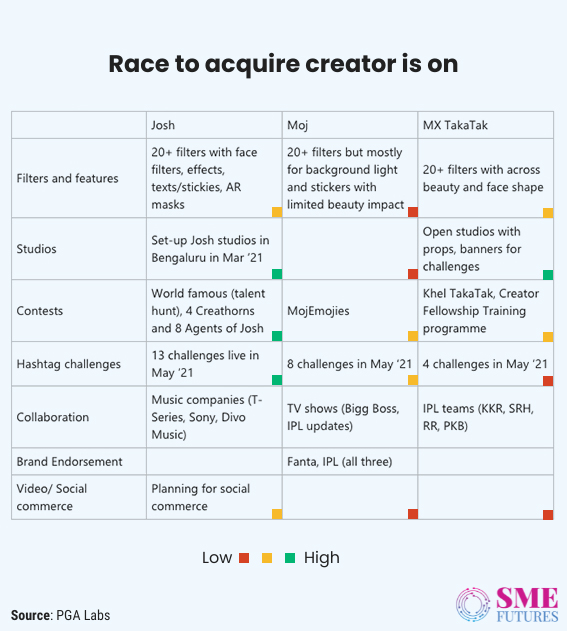
At the same time, we cannot have a clear-cut comparison between short and long format video platforms as they are judged on entirely different parameters.
The comparisons between both these formats are often based on similar sounding but different metrics. Short form is measured in views while long form is gauged via the number of viewers, like on YouTube for instance. Although both platforms rely on subscribers, the revenue for the former is generated by clicks. Whereas for the long form platforms, their revenue is generated through a commitment with their subscribers for at least a month or even years.
Overall, these players leveraged the opportunity which arose due to the TikTok ban and were able to design their products, execute their plans and market them aggressively. This shows the maturity of the ecosystem, which continues to flourish.
All said and done, they still have to reach the global and cross sector benchmarks on engagement and retention- which will further fuel the growth of the monetisation potential for the entire ecosystem.





